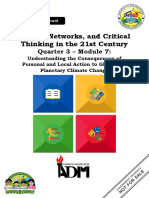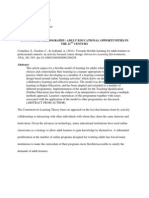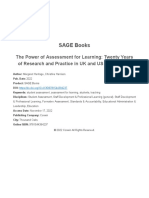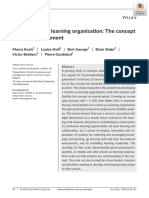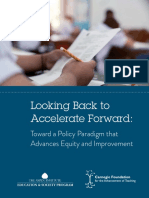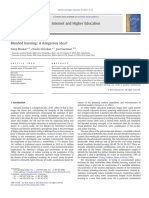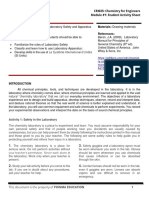ICELW 2015 June 10
th
-12
th
, New York, NY, USA The International Conference on E-Learning in the Workplace 2015, www.icelw.org ICELW 2013 Template #1
1
Designing and Evaluating Collaborative Projects in Learning Communities: Innovative Practices and Strategies
Suma Parahakaran PhD
Sathya Sai Academy, Kuala Lumpur, Malaysia
Abstract
This paper highlights a working model that can help build a framework for enhancing collective capacity building through
creating a “win
-
win” situation between sectors such as
corporates, universities, policy makers and the public sector. The model emphasizes higher impact educational practices as a desired and achievable learning outcome. The paper provides a short overview of existing challenges and
shortcomings of today’s E
-learning programs and the reasons why there needs to be an integrated approach for all three sectors. Although Open learning resources are available and online learning communities are workable, there are few evidence based research studies of Policy makers using the E-learning platforms as a collaborative tool to network for the betterment of the society. Past research conducted by the research team on e-platforms, revealed findings that there is a wide scope for collaborative projects integrated through e -learning that can contribute to enhance practical skills and gaining knowledge. Currently, the sharing of knowledge is limited and skewed towards academic excellence. At the same time, corporate companies are tight with budgets on areas that can be complemented through student interns. Peer to peer learning and research based learning can benefit both students and corporate companies through the establishment of joint projects. Integration of these learning communities by CSR taken up by corporates then stands to gain in the long term. The platform is then benchmarked for students to serve their communities and become reflective practitioners. The paper discusses four long-term objectives using learning communities. They are - :
Enhancing the capacity of professional learning communities to contribute to society and empower their participants themselves through a research informed experiential approach.
How corporate social responsibility can gain prominence and be used to capacity build at the local and global level.
Use of online educational resources for building collective research informed knowledge on critical social issues.
the ways in which students from tertiary institutions can contribute to solving key challenges in both local and global contexts through strategies that merge their service learning with the health, financial, economic and educational sectors. The results of the review will establish new grounds with new insights for Government and Policy makers to strengthen economy and upgrade education systems. Ethical and Context based Learning communities will become the crest jewel of any nation.
Index Terms:
Corporate Social Responsibility Learning Communities, Policymaking, Tertiary Education.
ICELW 2015 June 10
th
-12
th
, New York, NY, USA The International Conference on E-Learning in the Workplace 2015, www.icelw.org ICELW 2013 Template #1
2 INTRODUCTION This section introduces the existing roles and functions of learning communities, changes required in policies where e-learning programs are concerned and discusses the challenges faced by corporates venturing into social responsibility projects. Furthermore, the research includes a review of what constitutes a professional community. The discussion includes challenges that university faculties face in successfully implementing learning communities and concludes that the growth of these communities may not be successful unless policy changes and reforms are instituted.
A.
Learning Communities
With the world- wide expansion of e-learning programs the body of knowledge produced by these communities has also grown significantly wider. However, to date there have been no specific directions on how these learning communities can or do contribute more to society and individuals as compared to traditional modes of teaching. Bielaczyc and Collins (1999) argue that the current goal in education seeks excellence through individual pursuit. If learning communities are to be successful, then how do they become successful and in what ways do learning outcomes differ from traditional modes of teaching? How do we channel e-learning communities to include collaboration and networking systems for sustainability? These questions are still unanswered as e-learning must have specific outcomes which are far more beneficial to communities and create important avenues for advancement as compared to traditional ways of teaching. Considerable resources are required to create an e-learning program and hence there must be discrete outcomes and unique benefits which are not obtained through traditional modes of teaching. Although learning communities at the university level have become powerful platforms for students in both private and public universities, their efficacy levels have not been established yet (Smith, 2001). Smith (2001) asserted that there are challenges such as pedagogical issues, changes related to curriculum with regards to student learning as well as the need to meet the needs of students from diverse backgrounds. At another level, there are issues such as the retention and promotion of faculty staff in universities and institutions that implemented wide scale e-learning programmes and online learning communities. As Schaffert and Geser (2008) pointed out while there has been a notion that with the use of ICT, learning would become more student centred and move towards collaborative approach this has not happened as ascertained by educational institutions. As learning moves from individual to a collective voice, the dynamics will have to change or there must be some evidence of reforms happening on a different scale. Stoll, Bolam, McMohan, Wallace and Thomas (2006) stated that when professional communities increase their collective capacity it would lead to sustainability. In their review of what constitutes a professional learning community, it was noted that there are five shared features;
shared values
and
vision
,
collective responsibility
,
reflective professional enquiry
and
collaboration.
Their reviews also stated that the professional learning communities included value practices such as mutual trust, respect and extension of relationships that go beyond just school members and includes the community in many ways (Stoll et al, 2006). Kabes and Engstrom (2010) based on a qualitative study conducted with students from a Masters Education Program, reported enriched experiences from a Learning Community Program which was introduced with the aim of assisting students to become reflective practitioners. Similarly, Blitz (2013) reviewed studies of online communities of educators in order to establish whether these educators could achieve the goals of professional learning communities (PLC) by looking at traditional practices for PLC. The review results stated that opportunities maybe provided to teachers to become reflective practitioners and opportunities to collaborate with more flexible time given to them. These studies reveal that in learning communities, there are different requirements compared to traditional modes of teaching. Teachers need to have time for reflection and discussion and the curriculum has to be flexible enough to give time. With the establishment of new learning opportunities such as open educational resources, there are expectations that they will help students to learn faster and result in the establishment of a more knowledgeable community. The teacher directed teaching methods existing in many parts of online learning such as in Asia, become obstacles to form learning communities, especially with lack of time and in terms of space. Malie & Akir (2012) found that in traditional classrooms lectures (eighty nine in the sample) and explanation (ninety five) were the most favoured learning methods. The other learning methods (reading journals, books, and problem solving) were less popular
B.
Role of Policy makers and CSR services
Brown, Anderson and Murray (2007) conducted a documentary analysis of e-learning policy and strategies from 2000- 2005 across nine countries and six states and provinces. Their study resonates with issues that are widely prevalent in Asian countries. E-learning initiatives place a greater emphasis on formal education and have not been used to provide access to information of real life issues related to financial and social services, and their study of policy initiatives trigger us to question the actual use of e-learning programs. Do e-learning programs address the basic goals of education? Do Educational policy initiatives about e-learning at the tertiary level actually assist students have an education that helps them to achieve the goals of education and citizenship? Schaffert and Geser
’s
(2008) recommendations for policy makers suggest that students to be provided more access to open educational resources and the collaboration of private and public partnerships in innovative educational practices.
ICELW 2015 June 10
th
-12
th
, New York, NY, USA The International Conference on E-Learning in the Workplace 2015, www.icelw.org ICELW 2013 Template #1
2
C.
Corporate Social Responsibility (CSR)
The definition of corporate social responsibility (CSR) is varied. For the purpose of clarity, the author of this paper defines CSR as responsibility that brings honorable progress to the nation beyond its own financial progress and upholds ethical conduct by aligning to Government Policies. CSR is not for companies alone but it is a part of a larger network which benefits itself and the community it serves. The global online dialogue organized by the joint venture between the World Bank Institute, the Private Sector Development Vice Presidency of the World Bank, and the International Finance Corporation during the E- conference on
Public Policy for Corporate Social Responsibility
held between July 7- 25
th
in 2003 came up with interesting recommendations and findings. The main objective was to find out how public sectors can support CSR activities and come out with recommendations for Policy makers. The major suggestion was that governments could provide legally functioning structures with proper implementation procedures for public services. By setting up regulatory bodies they could eradicate corruption, bribery and unethical practices, giving incentives to CSR projects through tax benefits, recognizing their work and focusing on the gaps in the current agenda
(Petkoski & Twose, 2003)
.
An important outcome of the dialogue resulted in a suggestion that implementing CSR must be implemented at a local level. In addition, national guidelines for CSR could be developed so they become standards for CSR activities and their performance therefore can be assessed. The discussion also concluded with suggestions for governments to set up a properly functioning regulatory body to lead and enable the smooth running of public services. During the online global discussion, it was suggested that the role of the government should be to develop clear policy objectives and to practice socially responsibility by not giving the legal authority to non- elected private or public bodies. Here, the political justice must over rule other policies set by both private and public policies. However, where political sector is weak the suggestion by the participant was that the civil sector will have to support poor governance. Aud, Bernstein & Cashore (2008) stated that CSR services could go beyond the immediate needs of the market. This must ensure that CSR services go beyond enforced rules and regulations of the implemented projects. The goals of CSR must reap long-term benefits and have positive outcomes for stakeholders thus enhancing corporate sustainability (Porter and Kramer, 2006). Their review of CSR programs resulted in important findings on evaluation of CSR projects. They stated that the policy innovation and the relationship of the issues must have a direct relationship and the positive impact that CSR issues have must be long term. Corporates face challenges as they implement their services, as they have to deal with different agents. One of the emerging threads during the conference organized by the joint venture between the World Bank Institute, the Private Sector Development Vice Presidency of the World Bank, and the International Finance Corporation questioned whether the public sectors had the right incentives for actions by different corporates and enterprises. The report from the conference (Petkoski & Twose, 2003) also stated that there is a positive trend when one links performance and CSR. The discussion findings revealed that for CSR to be successful, the agents, governments and corporates as well as policy makers should be interactively involved (Petkoski & Twose, 2011). Do policy initiatives address the importance of collaborative work (Gunn, 1978, Hunter, 2003, Danaher, 2011)? Internationally non- government organisations (
NGO’s
) and joint bodies, commenting on a range of social and community issues have highlighted the negative consequences that result from a lack of collaboration between different sectors (Czikus,2011; United Nations Human Settlements Programme (United Nations Development Programme,2005 [UNHABITAT]; Primary and secondary schools assess children more on individual skills and knowledge outcomes. Consequently, they may leave school without the skills in collaborative work and problem solving required to help solve social and community based issues. While at the tertiary level, e-learning can be used as a tool to help support student learning the acquisition of the more practical skills such as networking skills can significantly help students during their collaborative projects with companies.
D.
Challenges in University e-learning programs
Increasing numbers of universities globally are integrating online learning into their courses. However, a review of studies suggests that there many obstacles. In China it was reported that staff and educators lacked the knowledge required to develop blended learning courses. Further reviews have also found that while university policies were favourable towards creating student centred learning, administrators and educators had limited potential to change the existing style of teaching. For example the study reported that in Korea, the unstimulating instructional contents in the courses was linked to a lack of interactivity with lecturers or instructionists. Similarly in Japan the e-learning programs retained traditional modes of teaching and simply added video and media
content to fulfil the ‘ble
nded or online learning component (Tham & Tham, 2011). Currently there are a number of studies which report on the challenges faced by tertiary level e-learning programs and highlight how the limited ways in which e-learning has been implemented that demotivates learners ultimately resulting in high drop- out rates (Yuen, 2011). A review of a Singapore based e-learning case study conducted by Thanasingam, Soong & Hu (2011) reported on a blended curriculum model on learning which was conducted via face to face tutorials, workshops and online learning. The review revealed the importance of the workshop sessions, consultations and online sessions in promoting meaningful student centred learning. This small-scale study confirmed that students prefer a combination of learning modes and that online components have to be meaningfully integrated with workshops, feedback sessions, space for peer-to-peer learning and tutoring by facilitators (Thanasingan, Soong & Hu, 2008).
ICELW 2015 June 10
th
-12
th
, New York, NY, USA The International Conference on E-Learning in the Workplace 2015, www.icelw.org ICELW 2013 Template #1
3 C
ONTEXT
:
LINKING
THE
GAPS
Integration of different sectors (policy-makers, corporates, university students and civil society) E.
.Research and Education in Malaysia
When projects with students were initiated by the Regional Centre in Education in Science and Mathematics (RECSAM) in Penang (Ng, 2012), the lesson learnt was that blended learning using constructivist approaches integrated with digital tools will be the future trend (Ng, 2012). The output of the study stressed on the need for engaging students on online platforms with various online digital tools and networking systems so that learning communities become a reality to solve real time issues (Ng, Parahakaran & Mee, 2015). This is depicted in Fig.1.
Figure.1. Webinar, Skype and Forums Source: Printscreen of chat messages with National and International guests, webinar trial run session (Chat 11) (27/2/2014) and SSYS forum (Chat 12) (7/3/2014). Ng, K.T, Parahakaran, S., Lei Mee, (2014).
F.
To make e-learning collaborative
Blended learning seems to be the most effective learning mode where e-learning is concerned. Universities in China, Korea, Japan and Singapore use blended learning approaches for e-learning (Kwongonn & Choikit, 2011). However, the researchers reported various limitations to blended learning including lack of pedagogical content, instructional methods and delivery methods. The researchers also found that in Singapore, the interest was more on show casing technology enhanced products rather than integrating knowledge based content in e-learning.
G.
Peer tutoring
To have successful e-
learning communities’
that work more collaboratively, research suggests peer-to-peer learning could be an effective strategy to ensure student retention. Wenger (2009) asserts that in both the public and private sectors e-learning has involved peer to peer learning and that this strategy is increasingly being used. There are students who network more with their peers and this is an untapped platform with great potential for creating large learning communities. The retention of students in online learning has its success in peer collaboration which can be used as a strategy to increase the learning resources students have access to and to link their practice with real life issues in the communities they live in. Peer tutoring on an informal basis helps increase skills related to communications, leadership and the social skills required for solving problems in academic education. A study, The effects of reciprocal peer tutoring compared to non- reciprocal peer tutoring conducted in the College of Engineering and Technology, New Era University (Henson,2012) found that reciprocal peer tutoring had the more positive effect on student learning and performance . The study consisted of sixty-eight engineering students enrolled in physics. The students switched roles as tutee and tutor within the ongoing sessions while in the non-reciprocal group, one way peer tutoring was organized. Online peer tutoring was conducted by peer mentors and class monitors in both groups. In both groups, eighty-nine percent felt that there had been a positive impact on their learning as they received help. In addition, the RPT group felt that peer to mentor relationship needed to be enhanced. The non-RPT group responded to a lesser extent (Henson, 2012). Based on this study it appears that peer to peer learning, particularly reciprocal learning, could be used as a strategy to encourage the development of large learning communities which in turn would a help produce large OER. H.
Evalution of Learning Communities
Evaluation in education has incorporated a blended approach, which includes both formative and summative approaches. Peer evaluation, use of analytics, and supervision of ongoing work by various experts can lead to engagement with and the development of learning communities. An evaluation of collaborative projects may include the criteria suggested by Diaz, Brown and Salmons (2010). This includes determining and observing fair distribution of work and requirements, timely reporting on team processes and progress and assessing student effectiveness in addressing issue and resolving problems (Diaz, Brown and Salmons,2010). The methodology used to integrate the affective domain
is through “Service
-
Learning” / “Community Service”
as one of the curricular components. An example of academic service Learning is provided in the url below: (https://www.wcupa.edu/_services/stu.slv/faculty.aspx).
Service learning helps students become reflective practitioners and critical thinkers. A feedback report of the



